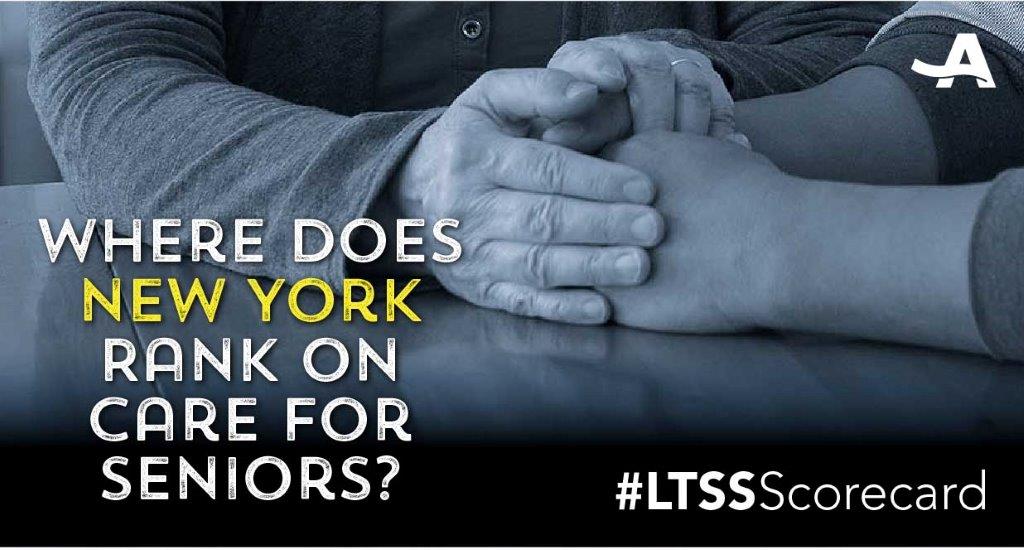AARP Hearing Center

ALBANY, N.Y. – While New York is doing a better job meeting the long-term care needs of seniors and adults with physical disabilities according to a new Long-Term Services and Supports State Scorecard , the Empire State needs to do more if it is to be among the nation’s top performers.
The 2017 Scorecard compiled by AARP, The Commonwealth Fund and The SCAN Foundation credited New York and Tennessee with the greatest overall improvement since the last Long-Term Services and Supports (LTSS) State Scorecard in 2014, but the report included some major warning signs for New York.
Chief among them is New York’s failure to prioritize community-based services that help New Yorkers age at home rather than in much costlier and mostly taxpayer-funded nursing homes.
The state ranked a dismal 43rd in the percentage of Medicaid aged/disabled LTSS users who first received services in the community rather than in institutional settings such as nursing homes. At 46 th in the percentage of new nursing home stays for Medicare beneficiaries lasting 100 days or more, New York is clearly not doing enough to ensure that individuals who enter nursing homes do not remain there long-term.
If New York improved its performance to the level of the average of the top five performing states, over $2 billion more would go to home- and community-based services instead of nursing homes, according to the Scorecard.
“The best way we can meet the promises to and the demands of our aging population is to better support family caregivers and prioritize funding of services at home, said AARP New York State Director Beth Finkel. “On average, nearly three people can receive care at home for the same cost as one in a nursing home. Now is the time for New York to invest more in those cost-effective home- and community-based services that New Yorkers want for themselves and their loved ones.”
For New Yorkers who have incomes too high to qualify for Medicaid but struggle to make ends meet, lack of sufficient funding has left at least 17,000 people on waiting lists for non-Medicaid in-home services. While AARP estimates it would take $25 million to eliminate those waiting lists, the current state budget added just $875,000 for the services – a mere 21 cents for every New Yorker 60 and older.
Noting New York City recently enacted a budget that added enough money to eliminate its waiting list for such services, Finkel added, “New York State can and should do better for its older residents. It would make more sense - and cents - to allow people to age in dignity in their own homes, as nearly nine of every 10 New Yorkers want. AARP calls on Governor Cuomo and the Legislature to follow New York City’s lead and make sure next year’s budget adequately funds compassionate, quality and cost-effective in-home services for the elderly.”
Those services not only help recipients directly, they provide invaluable support for the army of unpaid family caregivers who serve as the front line soldiers and backbone of the state’s long term care system. Nearly 2.6 million family caregivers provide unpaid care worth $31.3 billion annually in New York. And as the number of potential 45- to 64-year-old caregivers for every New Yorker 80 or older dwindle s, from 6.6 in 2010 to 3.5 in 2050, the need for in-home services will continue increasing.
An AARP New York/Siena College survey of New York Baby Boomers and Generation Xers released last fall found strong support for in-home services, with two-thirds or more of respondents saying transportation services, respite for family caregivers and assistance providing meals and managing household chores would be helpful.
While New York performed in the top half of states overall in the 2017 Scorecard, the Empire State still placed in the bottom half of states on affordability and accessibility (33 rd), quality of life and care (31 st) and effective transitions (32 nd).
The scorecard defines LTSS as daily-living assistance given to older adults and people with disabilities who cannot perform routine activities such as preparing meals, bathing, dressing and managing medications on their own because of physical, cognitive or chronic health conditions. The assistance also includes support to family caregivers.
Contact: Erik Kriss, ekriss@aarp.org
Follow us on Twitter: @AARPNY and Facebook: AARP New York
AARP is the nation’s largest nonprofit, nonpartisan organization dedicated to empowering Americans 50 and older to choose how they live as they age. With nearly 38 million members and offices in every state, the District of Columbia, Puerto Rico, and the U.S. Virgin Islands, AARP works to strengthen communities and advocate for what matters most to families with a focus on health security, financial stability and personal fulfillment. AARP also works for individuals in the marketplace by sparking new solutions and allowing carefully chosen, high-quality products and services to carry the AARP name. As a trusted source for news and information, AARP produces the world’s largest circulation publications, AARP The Magazine and AARP Bulletin. To learn more, visit www.aarp.org or follow @AARP and @AARPadvocates on social media.
###































































